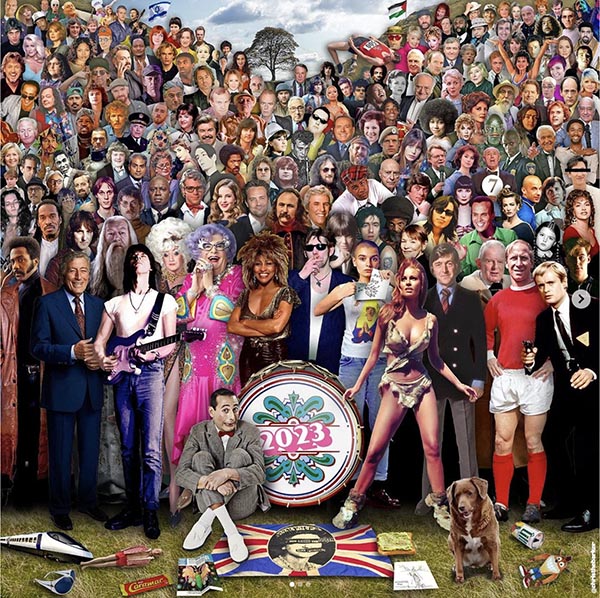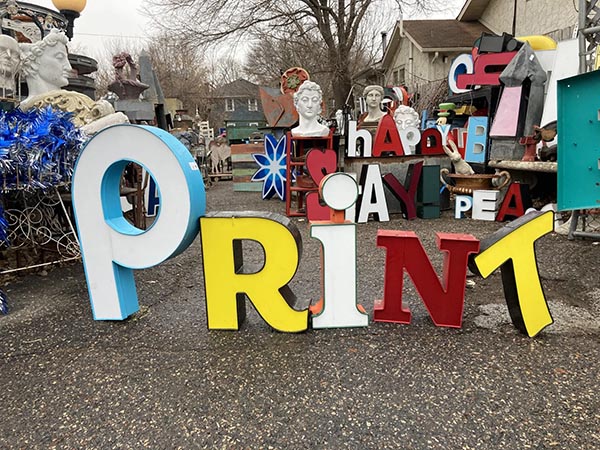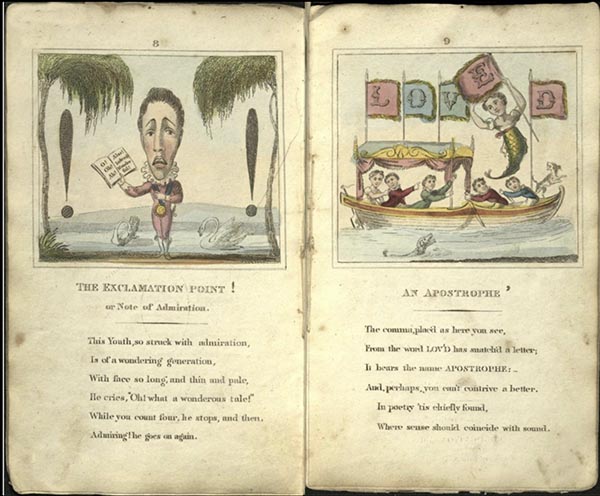
In Memoriam
Via Laughing Squid, art director Chris Barker has created a wonderful collage of the celebrities who died in 2023 in the style of The Beatles’ Sgt. Pepper’s Lonely Heart’s Club Band album cover.

Cover Stories
They say you shouldn’t judge a book by its cover, but publishers do actually want people to—twice. That is, if you frequent bookstores occasionally, you no doubt have seen that the paperback edition of a book often has a completely different design than the hardcover. The New York Times takes an interesting look behind the scenes of five books whose covers were redesigned from hardcover to paperback.
CHECKOUT 19
By Claire-Louise Bennett (Riverhead)
What it’s about A young woman falls in love with language in a small town outside London. The real setting for this experimental novel, though, is the narrator’s weird, brilliant and very funny mind.
Hardcover Kristine Moran’s abstract painting (and Jaya Miceli’s cover design) met the goal of conveying a complex inner life.
Makeover goals While the hardcover signaled a sense of wildness and a literary aesthetic, Riverhead also noticed that many readers were responding to the narrator’s snarky and original voice. The paperback cover, designed by Stephanie Ross, nods that way.
Paperback “We think the paperback art is pretty funny, which the hardcover certainly is not,” says Helen Yentus, Riverhead’s art director. “I personally instantly put myself in this woman’s place, whatever experience it is that got her to want to tangle herself in those sheets and stay there.”

Changing Channel Letters
One of the most common forms of signage is channel letters—physically constructed letters that are used to form words, logos, or other graphic elements on building exteriors. Rebranding often results in new letters being needed. But what happens to the old ones? Via Print magazine, sometimes they just end up in landfills, vacant lots, or junkyards.

But if you are in Minneapolis, you can buy and sell discarded channel letters at a store called hunt & gather.
Over 28 years, owner Kristi Stratton’s “vintage amusement store” in Minneapolis has sold oddities and curiosities, letters included. The letter lot just evolved. Today, it flourishes thanks to her long-established network of construction workers, friends, and salvagers who call their letter finds in, set a price, and drop them off.
The store even has an in-house typographer.
Meet Charlotte Staid. She’s mastered an area of typography you don’t get in design school. Markup is irrelevant; what point size would a letter four feet high be? And the fonts, only some are recognizable — in condensed, script, or italic forms. Exclamation marks, question marks, and periods, too. All in colors. Then there are mysterious letters belonging to some long lost logo, designer unknown.
Staid sorts the new arrivals and fills orders. Typesetting becomes a matter of hunting and climbing, with a bit of snow shoveling. If you need a red, lowercase “h,” Staid knows where it might be. Needless to say, there’s no spell check.
There is one big issue, though: unless there was a store called The Quick Brown Fox Jumps Over the Lazy Dog, a complete alphabet for a single font is non-existent.
Without intact alphabets, availability is an issue. “The letters have ‘scrabble value,'” she says. “Rare, high-value scrabble letters are just as scarce and prized on the lot. Like the ‘j,’ it’s always a problem. I take the top of a ‘t’ and splice it into part of a ‘u.’ It becomes a ‘j.'” Fusing all sides and surfaces of plastic and metal is part of her typesetting skills. It gives a new meaning to “make ready.

So if you’re looking for letters, you now know where to go.
Punctuality
And what would letters be without punctuation? Via Boing Boing, Punctuation Personified was a fun little book published in 1824, now available via The Public Domain Review. In the book, “Robert” is led through the world of punctuation by a Mr. Stops.
Mr. Stops introduces him to a cast of literal “characters”: there is Counsellor Comma, who knows “neither guile nor repentance” in his pursuit of “dividing short parts of a sentence”; Ensign Semicolon struts with militaristic pride, for “into two or more parts he’ll a sentence divide”; and The Exclamation Point is “struck with admiration”, his face “so long, and thin and pale”. Less common typographical marks get clustered into Arcimboldo-esque assemblages: a dash, circumflex, accent acute and grave, diereses, hyphen, and breve compose a rosy leafleteer, handing out fliers on punctuation to tentative children. And other personifications trade on iconic resemblances: ? is a “little crooked man” with a bent back and hat beneath his feet; ¶ carries a bindle and boards a boat toward distant shores, for the pilcrow announces something “distinct from what was read before”.

Table Talk
Do you need a coffee table? Do you also need a touchscreen display? Well, now you can buy both items at the same time. Via Core 77, the NXTABL Coffee Table is actually a tiltable 43-in. touchscreen monitor that runs Android.

Core 77’s Rain Noe isn’t sold on it.
I think constantly having to clean it off prior to tilting it would get tiresome, and whatever was on the table now has to go onto another object or the floor. And if you simply keep the surface clear at all times, then it isn't really a table and doesn't earn its keep.
That’s a perfectly fair point. But Kickstarter backers are a bit more sanguine.
At press time the NXTABL had blown well past its $10K goal, landing $160K and counting, with 15 days left to pledge. The table starts at $900 and is scheduled to ship this May.
Everything Old Is New Again
Ah, nostalgia isn’t what it used to be… Axios predicts that 2024 is going to see a lot of talk about what life was like before the Internet—primarily driven by the curiosity of those who never experienced it.
There’s been a pronounced generational tipping point: Boomers, Gen Xers and elder millennials are now the last people who remember what it was like to use a pay phone, a paper map, a typewriter, etc. — and they're being rapidly outnumbered by younger adults who don't.
Well, first of all, pay phones were gross and, in New York City at least, often doubled as bathrooms. Paper maps were hard to use if you were driving alone and wanted to avoid crashing. And typewriters made it hard to make corrections or rewrite things. We mock new technologies, but sometimes they’re actually an improvement. Sometimes.
There’s mounting fascination among the “youngs” in how people socialized, found where they were going, and got things done before the mid-1990s, when the internet, email and mobile phones started becoming common.
You could probably take any generation and find curiosity about how their forebears got stuff done. Kids in the 1970s marveled at how people lived before television and earlier generations no doubt wondered about life before cars or telephones. Young Romans probably asked their grandparents about life before aqueducts. And it’s a safe bet in 30 years or so the “youngs” will wonder how we all coped in the 2020s with our primitive smartphones and no cranial implants. We all just get stuff done with what we’ve got. Sometimes it’s easier than it used to be, sometimes it’s not.
Smellophone
If you were in an area last summer that was impacted by the wildfires in Canada you know how it feels on a “bad air day.” (Pro tip: don’t go running.) Alas, climate change is making air pollution worse in general, and increasing the likelihood of wildfires. As a result, we have greater need of air quality monitors that are more localized than what you usually find in weather reports. And, as you might expect, there’s an app for that. Or soon will be. Says Axios:
A startup called Mobile Physics has developed this technology, and Qualcomm and STMicroelectronics are embedding it in a forthcoming Android phone platform.
Why it matters: Air pollution is becoming a more urgent health issue for many amid a changing climate.
Details: Mobile Physics, an Israeli firm backed by Oracle founder Larry Ellison, says it can transform any cellphone into a personal “envirometer” and weather station.
It uses a phone’s existing sensors to measure air quality, smoke levels, temperature and UV exposure.
If the technology detects something worrisome, it alerts the user in real time — effectively functioning as a smoke detector or fire alarm that’s constantly running in the background.
So it’s almost quite literally “vaporware.” When can we get one?
“By sometime next year, you’ll have the option of buying a phone with this capability preinstalled,” predicts Stanford University professor Roger Kornberg, the 2006 Nobel Prize in Chemistry winner and chairman of Mobile Physics.
Graphene Takes (a) Charge
Was it a good week for graphene news? It’s always a good week for graphene news! Nanotech Energy’s graphene-based batteries are now available for pre-order! From (who else?) Graphene-Info:
The cells bring together Nanotech Energy's electrolyte and proprietary electrodes with Soteria metallized polymer current collectors to create a major advancement in battery technology. The result, as per the Company, is a 100% American-made non-flammable lithium-ion battery pack that has shown its strength and flexibility survived a remarkable abuse trial.
The cells, available on the Voltaplex website, are suitable for e-bikes, robotics, medical and military applications. They are manufactured exclusively in Nanotech Energy's new 50,000ft2 Chico 2 Production Plant In Chico, CA.
Time Is Literally Money
One of the most common tropes in science fiction is time travel, and it’s doubtful that time travel will ever become science fact. That no one from the future has come and visited us is often cited as good evidence that time travel will never be possible (unless they’re “youngs” and more curious about going back to the pre-Internet times). However, an article published in The Seeds of Science posits another, more practical reason for the lack of time travel capabilities: it wouldn’t make economic sense.
In this article, I argue an alternative explanation is that we are not economically important enough to our descendants to justify the costs of time travel. Using a cost-benefit analysis, I elaborate on this argument. I suggest that the major cost of time travel is likely to be the energy cost, whilst the largest benefit of time travel is knowledge which the present possesses, but the future has lost. Focusing on this benefit, I argue it is extremely unlikely that we possess a piece of knowledge which is sufficiently important to a future civilisation (system critical), but also has been lost by said civilisation. This is to say, we may not have been visited by time travellers because we are not important enough.
Fair point, but maybe “morbid curiosity” could be justification enough… Although, the plot of a fair number of time travel stories is someone going back in time and nefariously changing the future to benefit themselves economically. Or go back in time to bet on a winning horse or play winning lottery numbers. The options are as endless as time itself.
Ghost Busters
Via Atlas Obscura, an interesting story about a recent protest in the city of Pontianak, Indonesia, that was organized to protest the construction of a statue. The protest was organized by a group called GEMA TOPAN, which, in Indonesian, stands for “Community Movement to Reject Ghost Statue.” And, well, we have to admit it doesn’t sound like the greatest idea for a statue: a bloodthirsty ghost known as the kuntilanak.
The kuntilanak, also called a pontianak, is envisioned as a “woman with long and dishevelled hair and terrifying face, wearing a long, shabby white dress,” Severianus describes. Versions of her myth exist across Indonesia, Malaysia, and Singapore. In some, she is the ghost of a woman who died in childbirth or carries her dead baby in her womb. She allegedly takes revenge on bystanders by eviscerating them with her long claw-like nails and razor-sharp teeth.
Whose idea was it?
a man named Kartius, head of the Youth, Tourism and Sports Agency in West Kalimantan. Kartius proposed the idea to build the statue, arguing that the monument would increase tourism. Towering over 300 feet, the ghost would dwarf the buildings around it.

Image Generated by Victoria Ellis for Atlas Obscura using Midjourney
Doesn’t exactly stir civic pride, does it?
Kartius suggested a monument to this evicted spirit would celebrate the cultural heritage of Pontianak city. The sculpture would follow in the footsteps of the merlion statue in Singapore or the cat statues in Kuching, Malaysia. Given that Pontianak’s tourist attractions were getting rather dilapidated, long queues of tourists paying to climb the tower would provide a much-needed influx of cash. The enormous ghost wouldn’t only be a photo opportunity, Kartius suggested, it could overlook a nice, relaxing recreation centre.
Uh huh.
Locals were not pleased by the idea. Pontianak residents pointed out on social media that being able to see the monster of childhood nightmares quite literally everywhere you went in the city didn’t seem appealing. A poll showed 98% of residents were opposed to the idea.
Frankly Driving
Tired of the world of print? Looking for a change of career, or maybe some kind of side hustle? As it turns out, Oscar Mayer is looking for Wienermobile drivers. Says USA Today:
Oscar Mayer wants to hire a dozen “Hotdoggers,” for year-long full-time jobs driving its iconic 27-foot-long hot dog on wheels. If you relish the chance, you can apply through Jan. 31 on the Oscar Meyer website to be part of what will be the 37th class of Hotdoggers who drive the Wienermobile, which first hit the road in 1936.
Drivers travel and maintain one of the six Wienermobiles, traveling an average of 20,000 miles, visiting more than 20 states and handing out 250,000 Wiener Whistles during the year, the company says. They also create content for the brand’s social media channels.
And what, you may ask, are the qualifications?
- Strong communications skills and social media savvy.
- A bachelor's degree, preferably in public relations, communications, journalism or marketing.
- A love of hot dog puns is a helpful condiment.
Aside from the social media savvy, this could be right up our alley! Does it pay?
Applicants can expect a base salary of $35,600, according to the job listing. Other benefits include a weekly allowance of $150 (or $7,200 for the year) for meals
But only hot dogs, we suspect…
and personal travel, 18 days of paid time off, a full health benefits package, and 100% of hotel expenses covered.

Apply now and see if you cut the mustard!
Yipes Stripes!
Do you remember Fruit Stripe gum? For those of us of a certain age it was a ubiquitous grocery store checkout aisle staple, alongside all the Wrigley options. But, alas, via Food & Wine, it is being discontinued.
according to Fruit Stripe’s manufacturer, Ferrara Candy, the gum is being discontinued. (That’s big news to anyone who didn’t think it was discontinued about the time “Hannah Montana” went off the air.) “We have made the difficult decision to sunset Fruit Stripe Gum, but consumers may still be able to find the product at select retailers nationwide,” a Ferrara Candy representative said in a statement.

… Fruit Stripe was invented in the late 1960s by James Parker. It was originally manufactured and sold by the Beech-Nut Confection Division, before being passed off in various mergers and acquisitions to Nabisco, Hershey, and Farley’s & Sathers Candy Company, which joined forces with Ferrara Pan Candy to create the Ferrara Candy Company.
The company had recently launched Fruit Stripe gummy candies, which they also apparently have discontinued.
This Week in Printing, Publishing, and Media History
January 1
1772: The first traveler’s checks, which could be used in 90 European cities, are issued by the London Credit Exchange Company.
1773: The hymn that became known as “Amazing Grace,” then titled “1 Chronicles 17:16–17,” is first used to accompany a sermon led by John Newton in the town of Olney, Buckinghamshire, England.
1788: First edition of The Times of London, previously The Daily Universal Register, is published.
1879: English author and playwright E. M. Forster born.
1919: American soldier and author J. D. Salinger born.
1933: English dramatist Joe Orton born.
1970: The defined beginning of Unix time, at 00:00:00.
1971: Cigarette advertisements are banned on American television.
1983: The ARPANET officially changes to using the Internet Protocol, creating the Internet.
1984: The original American Telephone & Telegraph Company is divested of its 22 Bell System companies as a result of the settlement of the 1974 United States Department of Justice antitrust suit against AT&T.
1985: The first British mobile phone call is made by Michael Harrison to his father Sir Ernest Harrison, chairman of Vodafone.
1992: American computer scientist and admiral, co-developer of COBOL Grace Hopper dies (b. 1906).
1999: Euro currency is introduced in 11 member nations of the European Union (with the exception of the United Kingdom, Denmark, Greece and Sweden; Greece later adopts the euro).
January 2
1818: The British Institution of Civil Engineers is founded by a group of six engineers; Thomas Telford would later become its first president.
1920: American science fiction writer Isaac Asimov born.
1929: American author and screenwriter Charles Beaumont born.
January 3
1749: The first issue of Berlingske, Denmark’s oldest continually operating newspaper, is published.
1870: Construction work begins on the Brooklyn Bridge in New York.
1892: English writer, poet, and philologist J.R.R. Tolkien born.
1926: English composer, conductor, and producer George Martin born.
1947: Proceedings of the U.S. Congress are televised for the first time.
1957: The Hamilton Watch Company introduces the first electric watch.
1977: Apple Computer is incorporated.
2000: Final daily edition of the Peanuts comic strip.
January 4
1643: English mathematician and physicist Isaac Newton born.
1809: French educator, inventor of Braille Louis Braille born.
1853: After having been kidnapped and sold into slavery in the American South, Solomon Northup regains his freedom; his memoir Twelve Years a Slave later becomes a national bestseller.
1958: Sputnik 1, the first artificial Earth satellite, launched by the Soviet Union in 1957, falls to Earth from orbit.
1960: French novelist, philosopher, and journalist, Nobel Prize laureate Albert Camus dies (b. 1913).
1965: American-English poet, playwright, and critic, Nobel Prize laureate T. S. Eliot dies (b. 1888).
January 5
1932: Italian novelist, literary critic, and philosopher Umberto Eco born.
1944: The Daily Mail becomes the first transoceanic newspaper.
1953: The play Waiting for Godot by Samuel Beckett is first performed.
January 6
1838: Alfred Vail demonstrates a telegraph system using dots and dashes (this is the forerunner of Morse code).
1852: French educator, inventor of Braille Louis Braille dies (b. 1809).
1878: American poet and historian Carl Sandburg born.
1912: German geophysicist Alfred Wegener first presents his theory of continental drift. (Afterward, everyone slowly moved away from him.)
1931: Thomas Edison signs his last patent application.
1931: American novelist, playwright, and short story writer E. L. Doctorow born.
1946: Shine on, you crazy diamond: English singer-songwriter and guitarist Syd Barrett born.
2000: Kerplonk! American cartoonist Don Martin dies (b. 1931).
January 7
1706: German publisher Johann Heinrich Zedler born.
1831: German postman and founder of the Universal Postal Union Heinrich von Stephan born.
1873: Hungarian-American film producer and co-founder of Paramount Pictures Adolph Zukor born.
1894: William Kennedy Dickson receives a patent for motion picture film.
1912: American cartoonist Charles Addams born.
1927: The first transatlantic telephone service is established from New York City to London.
January 8
1547: The first Lithuanian-language book, Simple Words of Catechism, is published in Königsberg.
1642: Italian physicist, mathematician, astronomer, and philosopher Galileo Galilei dies (b. 1564).
1775: English printer and type designer John Baskerville dies (b. 1706).
1824: English novelist, playwright, and short story writer Wilkie Collins born.
1862: American publisher and founded of the Doubleday Publishing Company Frank Nelson Doubleday born.
1889: Herman Hollerith is issued US patent #395,791 for the “Art of Applying Statistics”—his punched card calculator.
1904: The Blackstone Library is dedicated, marking the beginning of the Chicago Public Library system.
1935: Elvis Presley born.
1941: English actor, screenwriter, and Monty Python member Graham Chapman born.
1942: English physicist and author Stephen Hawking born.
1947: English singer-songwriter, producer, and actor David Bowie born.
January 9
1606: English printer William Dugard born.
1890: Czech author and playwright Karel ?apek born. His play R.U.R. coined the word “robot.”
1944: English guitarist, songwriter, and producer Jimmy Page born.
January 10
1754: English publisher, founder of The Gentleman’s Magazine Edward Cave dies (b. 1691).
1776: Thomas Paine publishes his pamphlet Common Sense.
1927: Fritz Lang’s futuristic film Metropolis is released in Germany.
1990: Time Warner is formed by the merger of Time Inc. and Warner Communications.
January 11
1927: Louis B. Mayer, head of film studio Metro-Goldwyn-Mayer (MGM), announces the creation of the Academy of Motion Picture Arts and Sciences, at a banquet in Los Angeles, California.
1928: English novelist and poet Thomas Hardy dies (b. 1840).
1949: The first “networked” television broadcasts took place as KDKA-TV in Pittsburgh, Pa., goes on the air connecting the east coast and mid-west programming.
1964: Surgeon General of the United States Dr. Luther Terry, M.D., publishes the landmark report Smoking and Health: Report of the Advisory Committee to the Surgeon General of the United States saying that smoking may be hazardous to health, sparking national and worldwide anti-smoking efforts.
1755: General, economist, and politician, 1st United States Secretary of the Treasury, “Ten-Dollar Founding Father” Alexander Hamilton born.
1807: American businessman and philanthropist, founder of Western Union and Cornell University Ezra Cornell born.
January 12
1908: A long-distance radio message is sent from the Eiffel Tower for the first time.
1949: Japanese novelist, short-story writer, and essayist Haruki Murakami born.
1976: English crime novelist, short story writer, and playwright Agatha Christie dies (b. 1890).
January 13
1888: The National Geographic Society is founded in Washington, D.C.
1898: Émile Zola’s J’accuse…! exposes the Dreyfus affair.
1910: The first public radio broadcast takes place; a live performance of the operas Cavalleria rusticana and Pagliacci are sent out over the airwaves from the Metropolitan Opera House in New York.
1941: Irish novelist, short story writer, and poet James Joyce dies (b. 1882).
2009: Irish-American actor, director, and producer Patrick McGoohan dies (b. 1928). Be seeing you.
January 14
1896: American novelist, poet, essayist, and playwright John Dos Passos born.
1898: English novelist, poet, and mathematician Lewis Carroll (né Charles Dodgson) dies (b. 1832).
1952: NBC's long-running morning news program Today debuts, with host Dave Garroway.
1967: The Human Be-In takes place in San Francisco, California’s Golden Gate Park, launching the Summer of Love.
1973: Elvis Presley’s concert Aloha from Hawaii is broadcast live via satellite, and sets the record as the most watched broadcast by an individual entertainer in television history.










Discussion
Join the discussion Sign In or Become a Member, doing so is simple and free